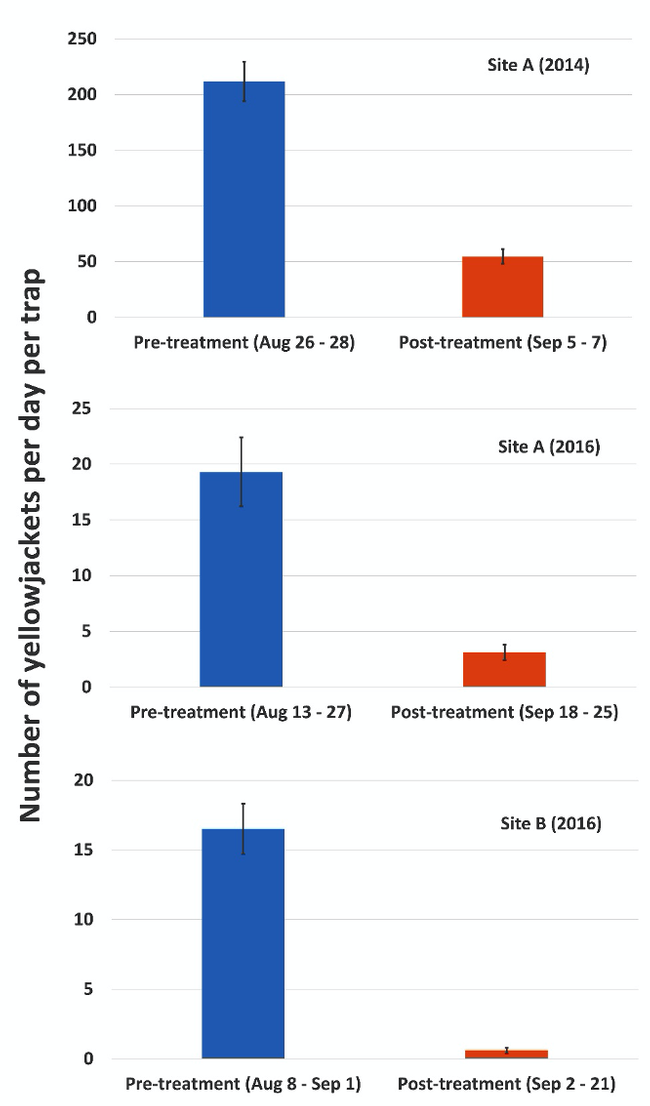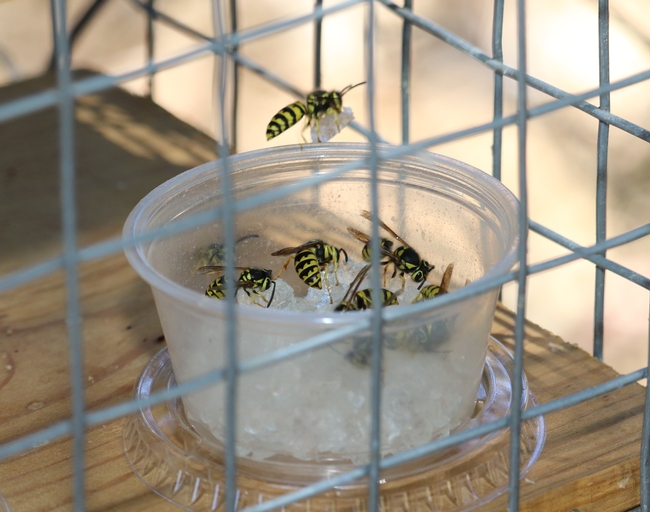Many parks, recreational areas, and outdoor venues in California are home to yellowjacket wasps (Vespula spp.). Yellowjackets are commonly attracted to human food items, creating a serious nuisance and a potential stinging threat. If found, nests (usually underground) can be effectively treated with targeted insecticide applications (e.g., dusts containing pyrethroids). However, baiting could be a feasible alternative method to suppress yellowjackets over a wide area, especially if nests cannot be located. Currently, only one active ingredient (esfenvalerate) is registered for use within bait in California to control yellowjackets, and its efficacy is marginal because it is repellent and fast-acting. Effective active ingredients and optimal bait formulations have yet to be identified.
Foraging wasps seek out protein-rich foods for developing larvae in the nest. These foragers have strong preferences for some meats, and in the past, meats impregnated with insecticides have been used as baits. However, meat loses its attractiveness after less than a day, requiring the use of fresh meat, which has been a major hurdle in developing a commercial ”ready-to-use” bait product.
To overcome this challenge, a team of researchers from the University of California conducted experimental trials using non-meat materials as matrices for yellowjacket baits. Due to their high absorbency of water and water-soluble compounds as well as biological inertness, hydrogels were considered as possible candidates for this use. As a first step in this investigation, we observed whether foraging western yellowjacket wasps (V. pensylvanica) would accept polyacrylamide hydrogel crystals that were hydrated with chicken juice containing a toxicant.
Field Trials
The study was conducted at two different sites in southern California. Site A was a private country club (~15 acres) with supporting recreational infrastructure (e.g., picnic tables, barbecue facilities, children's playgrounds, etc.). The site was surrounded by mixed conifer and oak forest. Site B was a multiple-use regional park (~161 acres) surrounded by undeveloped wilderness areas composed primarily of riparian and coastal sage scrub. Yellowjacket foraging activity was monitored using traps containing a chemical lure, heptyl butyrate.
In 2014 and 2016, sites were baited with hydrogel bait with 0.025% (wt/wt) fipronil*. Ten yellowjackets per trap per day was used as an action threshold for baiting. To prevent consumption by non-target organisms, the bait was provided at “bait stations” within three small plastic cups placed inside a cage.
Wasps were readily attracted to the bait, manipulated the bait with their mandibles, and flew away with small pieces of the bait (Figure 1). After 24 hours, the approximate amount of bait removed from in each cup in grams (g) was estimated.
Results

The behavioral observations at the bait stations and the amount of bait taken clearly indicated that polyacrylamide hydrogel was an excellent matrix for yellowjacket baiting. The meat-like physical texture and chemical inertness of the hydrogel may explain its acceptance by foraging yellowjackets. With its ability to absorb large amounts of liquids and to resist evaporation, hydrogel bait might also remain palatable for longer periods of time compared with meat-based bait.
The use of hydrogel for bait formulation may enable manufacturers to develop a commercial ready-to-use bait product for yellowjacket control. Hydrogel baits could be pre-packaged in bait containers, though dehydrated formulations would need to be hydrated with a prescribed amount of water before use. We observed that very few non-target insects were attracted to these baits; Argentine ants and velvety tree ants were occasionally seen foraging at the bait stations. Ants were excluded by using commonly available pyrethroid-impregnated “ant guards” designed for hummingbird feeders. This study used the liquid contents from canned chicken meat as an attractant / feeding stimulant. We are currently working on replacing this “chicken juice” with a mixture of synthetic and natural attractants and feeding stimulants which would be better suited for commercialization.
*Use of fipronil in combination with chicken meat (or juice) is strictly experimental and is not registered for yellowjacket control in California. Such use by licensed professionals would currently be considered illegal.
[Originally published in the Winter 2020 issue of the Green Bulletin.]
